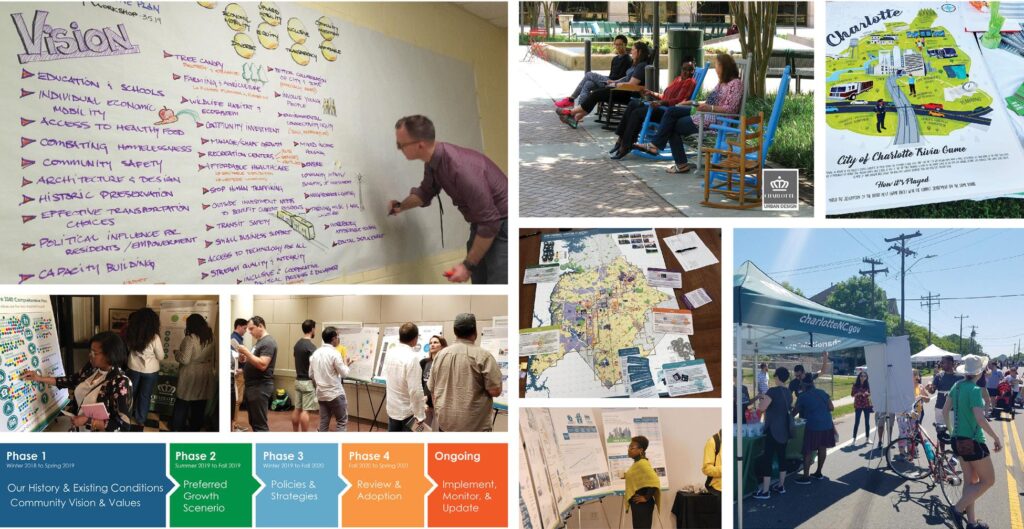Home / 01. A Community-Based Vision / 1.2 Community Values, Vision, and Goals
Plan Policy
Table of contents
1.2 Community Values, Vision, and Goals
In order to create a Comprehensive Plan that is successful and meaningful, the values of the community must be central to the process and outcomes. This understanding is at the heart of the Charlotte Future 2040 Comprehensive Plan. Building on the efforts of previous engagement efforts, the Plan’s equitable and inclusive process focused on hearing from a great number and variety of voices. What we learned from the community led to the development of guiding principles and vision elements that are true to Charlotte’s character and the needs of all Charlotteans. As Charlotte continues to grow and welcome newcomers from around the country and the globe, it will be critical to foster a community ethic of diversity, equity, inclusion, and belonging. The values, vision, and goals for Charlotte embrace and celebrate differences, as well as the places and opportunities that unite us. The timeline, methods, and outcomes of the community values and Plan process are described in this section.

The development of the Charlotte Future 2040 Comprehensive Plan has been a nearly 3-year process, including eight additional months for review and adoption. This process included significant analysis, community outreach, education, and coordination across departments, organizations, and entities. To simplify the process and engagement, the project schedule was divided into four phases.
The first phase, from Winter 2018 to Spring 2019 focused on Charlotte’s history, existing conditions, and community vision and values. This phase included significant community outreach, leading to the creation of the Plan’s guiding principles and vision elements. An analysis of the city’s existing conditions and the impacts of past policies was also completed and represented in the Built City Equity Atlas, the Growth Factors Report, and the Policy Audit. The goal of this phase was to understand the impacts of our history, the city of Charlotte as it is today, and the community’s vision for its future.
The second phase, from Summer 2019 through Fall 2019, focused on growth strategies; examining the implication of concentrating future growth along corridors, in and around major activity centers, or in and around neighborhood nodes. The process of educating and engaging the community about growth began with the Growing Better Places Game, an innovative and fun approach to having complex conversations around growth and trade-offs. The input received from the game informed the creation of three growth scenarios. The community learned about and weighed-in on these different strategies for locating future growth. Both the data analysis and the community’s feedback on these scenarios helped establish and support the notion that future growth should not be distributed through “business as usual,” but rather through an intentional and coordinated growth strategy.
The third phase, from Winter 2019 to Fall 2020, focused on the development of policies, projects, and programs around our future growth strategies and overall vision. During this phase the community, and particularly the Plan Ambassadors and Strategic Advisors, weighed in on the ten main goals and objectives that form the policy framework; the data and conclusions from the Equitable Growth Framework; and the ten Place Types. During this phase, all of the content, community feedback, and analysis to-date were compiled and released in the Public Review Draft Plan.
In the fourth phase, from Fall 2020 to Summer 2021, the initial and revised draft Plan documents were released and reviewed by the Charlotte City Council and the community. An eight-month review phase culminated in Council adoption on June 21st, 2021. During this phase feedback was collected in a variety of ways from many voices throughout Charlotte. The Final Plan was then edited to incorporate the feedback received. Following adoption, the Plan is in the process of ongoing implementation and monitoring to ensure the goals and objectives are being met.
To ensure that the final Comprehensive Plan represents an equitable future for all residents, the public engagement process was robust, innovative, and inclusive. The planning team engaged many perspectives through a variety of tools so that all Charlotteans could be included at the table. The outreach focused on accessibility and we listened to input from groups representing all segments of Charlotte’s population, including those we don’t hear from often enough – people of color, youth, non-English speaking residents, and those with lower incomes.

Over the course of the planning process the team had over 500,000+ interactions with over 6,500 voices through more than 40 methods of engagement. An additional 477 key stakeholders, including community leaders, local business and non-profit representatives, advocacy groups, major employers, local institutions, and neighborhood groups from across Charlotte.
Overall goals for engagement included to increase awareness of the Comprehensive Plan and its purpose; to advance understanding of equity; to build community relationships; to meet people where they are; to attract diverse participation; to clearly communicate the community’s inputs will influence the plan; and to gather feedback on the plan process and deliverables.
The primary methods for plan engagement included workshops, open houses, online surveys, pop-up events, the Growing Better Places Board Game, Ambassadors and Strategic Advisors meetings, Elected and Appointed Officials meetings and workshops, virtual meetings and open houses, the Charlotte Card Game, a socially-distanced drive-in workshop, social media outreach and education, and focus groups. All in-person meetings included translation services, refreshments, and access to childcare. All major materials were translated into Spanish and information from the project website can be translated into over 100 languages.
Starting in the Spring of 2020, with the onset of the novel COVID-19 virus, the approach for engagement needed to pivot quickly and significantly. While the overall goals of the engagement process did not change, and equity and inclusion remained at the center of the effort, the methods of outreach became completely socially distanced and/or virtual in order to protect the public health. Efforts switched to focus on safe engagement activities that primarily kept the public interested and up to date on the Plan, while more specific surveys and virtual meetings were targeted towards the Plan Ambassadors and Strategic Advisors. Acknowledging that people’s schedules and day-to-day lives may have changed during this time, the invitation to be a Strategic Advisor was re-opened to all members of the community. Some fun, at-home engagement methods included Charlotte Future City Building coloring sheets and contest, a Charlotte planning Tik Tok Challenge, a virtual scavenger hunt, the Charlotte Future card game, socially-distanced chalk the walk, and social media games and quizzes. Many activities during this time were aimed at young adults and families, who may have had more capacity or the need for activities during school closures.
Throughout each phase of the Plan public input was compiled and integrated into deliverables and recommendations. Emerging themes were major drivers of the final plan goals and strategies. Some of the themes expressed most often throughout the process included:
- Accommodate projected growth along our transit/transportation corridors;
- Allow varieties of housing types in neighborhoods around mixed-use activity centers;
- Create more walkable and bikeable communities;
- The strong desire to rethink “business as usual”;
- The need for missing middle, diverse, and affordable housing options;
- Strong support for complete neighborhoods and equitable access to goods and services;
- Protect and create a healthy and robust tree canopy;
- Create more meaningful and accessible tree-canopied parks and open space; and
- The need for better access to a diverse range of jobs and employment types.
With significant input from the public at every phase in the process, this Plan and its recommendations could not have been created without the help of the Charlotte community. The community’s willingness to participate in a variety of honest and sometimes difficult conversations throughout the development of the Comprehensive Plan has been instrumental to its creation.
The process of community outreach and visioning began with the creation of the Guiding Principles. Guiding principles are the values that Charlotte will use to establish a framework for decision-making throughout the life of the Charlotte Future 2040 Comprehensive Plan. These principles were conceived through robust and meaningful conversations with over 6,500 voices from the community. The four guiding principles that emerged will help shape the Comprehensive Plan as it looks to the future: equitable, authentic, integrated, and resilient. These principles form the basis for the Plan vision and goals and ensure that the recommendations are in-line with how we as a community want to grow and change in the coming years.

Equitable
Equity is not simply a part of our plan; acknowledging and working to correct Charlotte’s legacy of discriminatory policies and practices is one of the Plan’s primary driving forces. Keeping equity at the root of the Plan ensures that future actions contribute to every member of our community having the resources, skills, access, and sense of belonging that they need.
Authentic
For the Comprehensive Plan to be successful, it must be true to the city’s history and character. This authenticity has been shaped through an extensive public process and honest feedback from all voices and perspectives in Charlotte about our city’s strengths and challenges.
Integrated
A key purpose of the Plan is creating an integrated framework for growth, development, and community design. Unifying our City and County departments, as well as non-government partners, around a holistic long-range plan ensures we are committed to a shared vision for Charlotte and working together to address challenges and create opportunities. This Plan was not completed in isolation; there other plans that it connects with.
Resilient
An underlying piece of all the goals is resiliency, particularly around how Charlotte prepares for and responds to the challenges of public health, affordable housing, climate change, and infrastructure. A resilient city has the ability to absorb, adapt, and grow from current and future trends, stresses and shocks.
Continuing from the community’s values that established the guiding principles, five vision elements were created to help inform the coming goals and equity metrics. These vision elements describe how Charlotteans picture their city in the future. In addition to being equitable, authentic, integrated, and resilient as stated in the Guiding Principles, the Charlotte of tomorrow is inclusive and diverse, livable and connected, healthy and sustainable, prosperous and innovative, and regional. This vision also reflects the lens through which goals and objectives were created and analyzed.

City of Charlotte Vision: “Charlotte is America’s Queen City, opening her arms to a diverse and inclusive community of residents, businesses, and visitors alike; a safe family-oriented city where people work together to help everyone thrive.”
Inclusive & Diverse
An Inclusive and Diverse City welcomes and accommodates people of all walks of life. It unpacks, measures, and mitigates displacement risk. It preserves and expands access to affordable housing. It provides services and choices for daily goods and services for a variety of price points and promotes environmental justice.
Livable & Connected
A Livable and Connected City provides public services and infrastructure to maintain an accessible environment for all. Livability manifests as complete neighborhoods that provide essential goods and services, multimodal transportation networks, a diverse array of public spaces, and a respect for neighborhood character.
Healthy & Sustainable
A Healthy and Sustainable City incorporates environmental protection and sustainability to improve public health for all. It addresses access to healthy food, health care, tree canopy, and recreation. In the context of climate change, it plans for adaptability and mitigation by enhancing stormwater infrastructure, waste diversion strategies, our tree canopy and energy efficiency.
Prosperous & Innovative
A Prosperous and Innovative City leverages growth to benefit the livelihoods and economic opportunities of all residents. It develops diverse employment opportunities that are well-matched to residents’ skill levels, expanding access to higher education and job-training for all, and supporting innovative entrepreneurs and small businesses.
Regional
The Regional City serves to improve linkages with the broader region at the political, social, and economic levels. Active participation in multi-jurisdictional planning efforts can contribute to large-scale improvements in transportation infrastructure which enhance physical and economic links between cities in the region.
